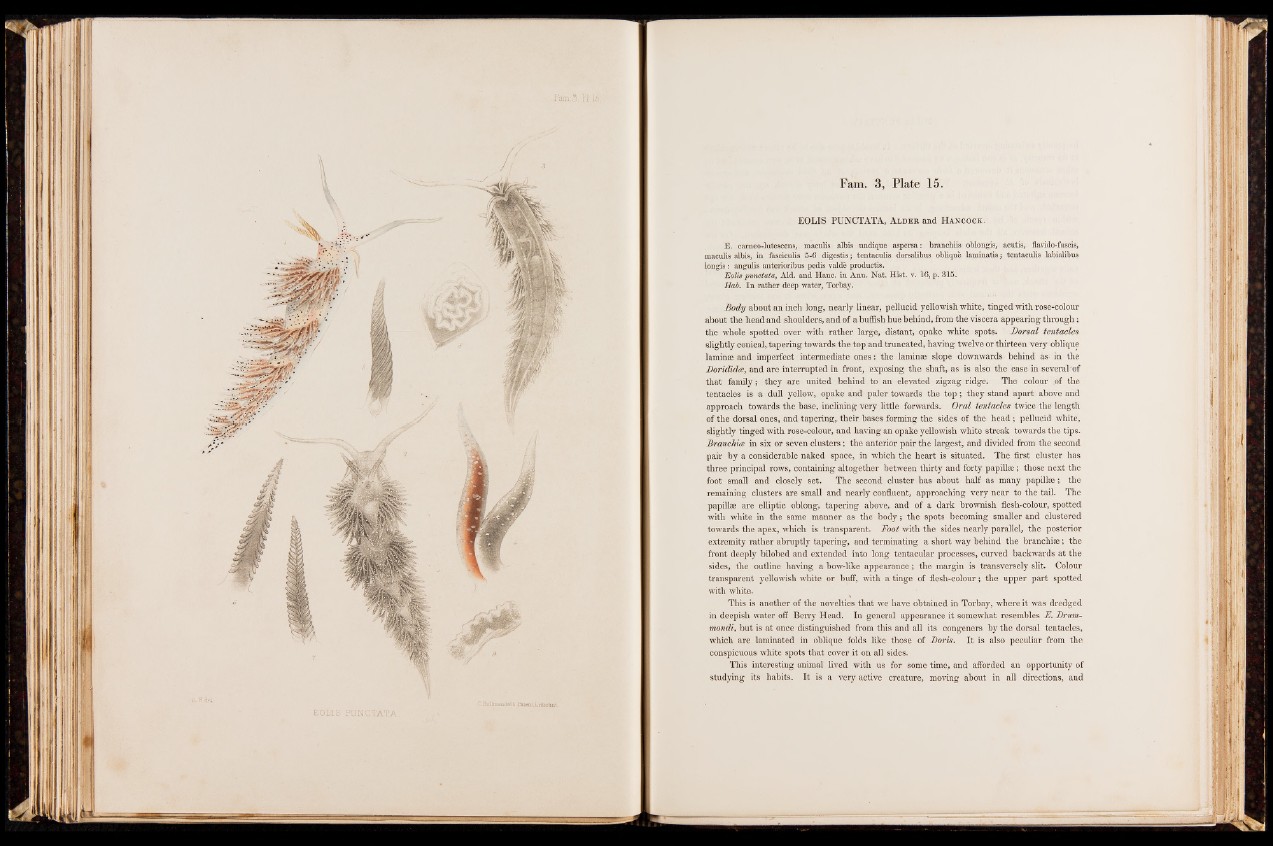
EOLIS PUNCTATA, Alder and Hancock.
E. cameo-lutescens, maculis albis undique aspersa: branchiis oblongis, acutis, flavido-fuscis,
maculis albis, in fasciculis 5-6 digestis; tentaculis dorsalibus oblique laminatis; tentaculis labialibus
longis : angulis anterioribus pedis valde productis.
Eolis punctata, Aid. and Hanc. in Ann. Nat. Hist. v. 16, p. 315.
Hub. In rather deep water, Torbay.
Body about an inch long, nearly linear, pellucid yellowish white, tinged with rose-colour
about the head and shoulders, and of a huffish hue behind, from the viscera appearing through;
the whole spotted over with rather large, distant, opake white spots. Dorsal tentacles
slightly conical, tapering towards the top and truncated, having twelve or thirteen very oblique
laminae and imperfect intermediate ones: the laminae slope downwards behind as in the
Dorididce, and are interrupted in front, exposing the shaft, as is also the case in several'of
that family; they are united behind to an elevated zigzag ridge. The colour of the
tentacles is a dull yellow, opake and paler towards the top; they stand apart above and
approach towards the base, inclining very little forwards. Oral tentacles twice the length
of the dorsal ones, and tapering, their bases forming the sides of the head ; pellucid white,
slightly tinged with rose-colour, and having an opake yellowish white streak towards the tips.
Branchice in six or seven clusters; the anterior pair the largest, and divided from the second
pair by a considerable naked space, in which the heart is situated. The first cluster has
three principal rows, containing altogether between thirty and forty papilloe; those next the
foot small and closely set. The second cluster has about half as many papillae; the
remaining clusters are small and nearly confluent, approaching very near to the tail. The
papillae are elliptic oblong, tapering above, and of a dark brownish flesh-colour, spotted
with white in the same manner as the body; the spots becoming smaller and clustered
towards the apex, which is transparent. Foot with the sides nearly parallel, the posterior
extremity rather abruptly tapering, and terminating a short way behind the branchiae; the
front deeply bilobed and extended into long tentacular processes, curved backwards at the
sides, the outline having a bow-like appearance; the margin is transversely slit. Colour
transparent yellowish white or buff, with a tinge of flesh-colour; the upper part spotted
with white.
This is another of the novelties that we have obtained in Torbay, where it was dredged
in deepish water off Berry Head. In general appearance it somewhat resembles E. Drum-
mondi, but is at once distinguished from this arid all its congeners by the dorsal tentacles,
which are laminated in oblique folds like those of Doris. It is also peculiar from the
conspicuous white spots that cover it on all sides.
This interesting animal lived with us for some time, and afforded an opportunity of
studying its habits. It is a very active creature, moving about in all directions, and